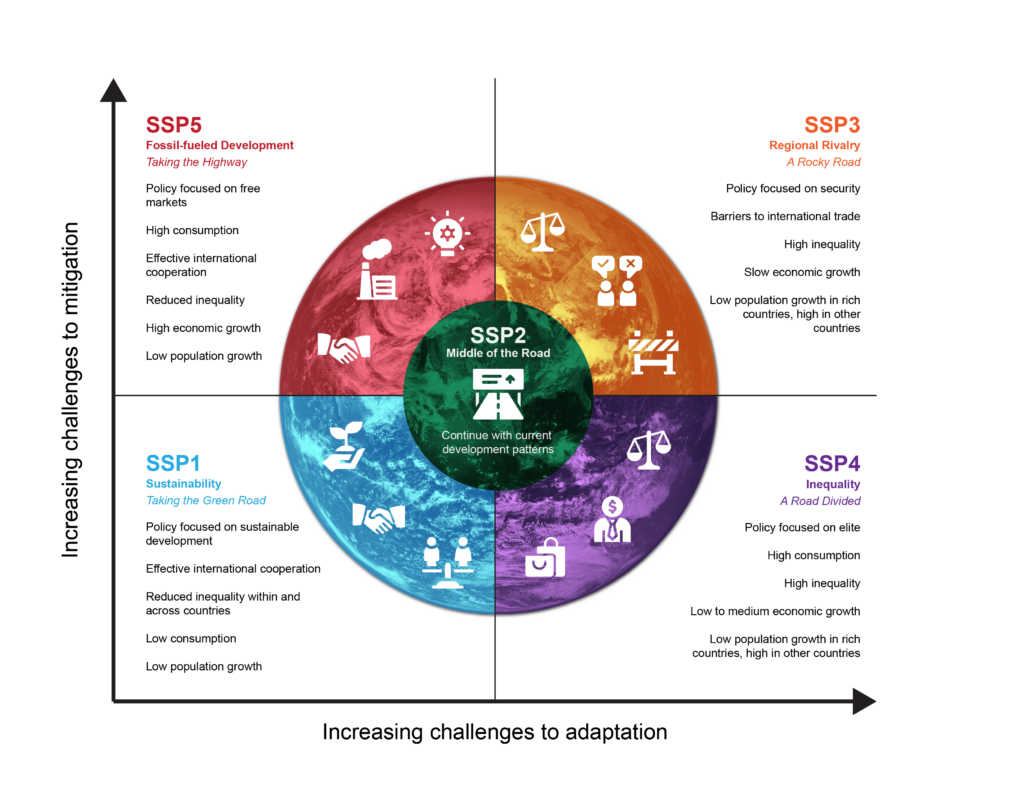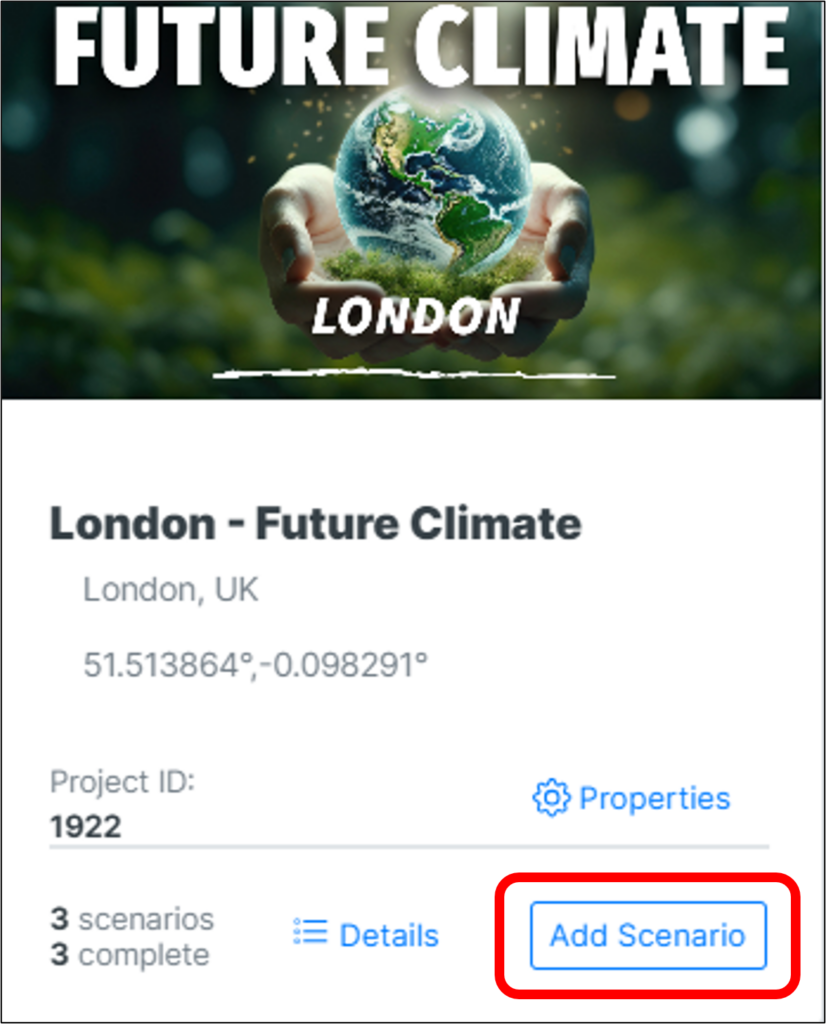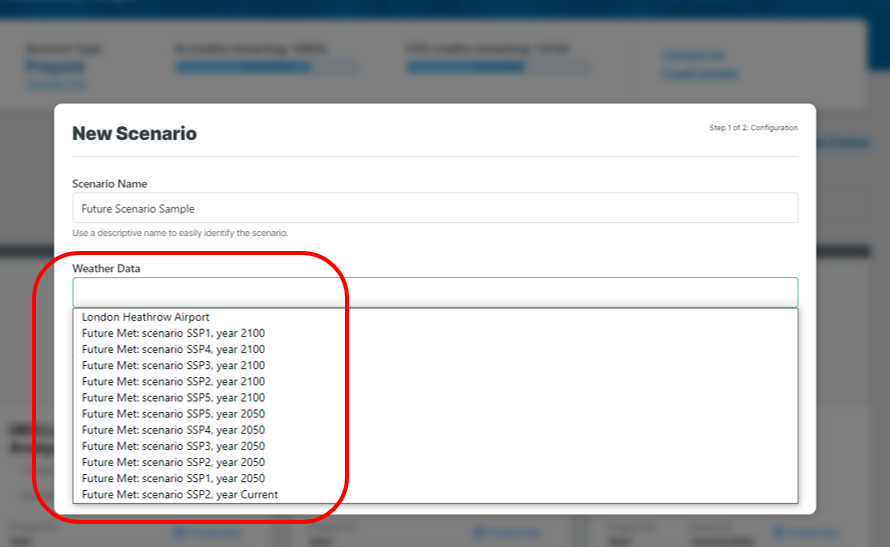Orbital Stack offers an optional feature to use future climate data for your microclimate simulations.
Traditional climate analysis typically examines trends in historical data under the assumption that these can reasonably predict future conditions. With increasing impacts of climate change, this approach may not provide the best estimates for conditions in 2050 and beyond. For this reason Orbital Stack, together with our climate data provider, are offering weather estimates based on a number of future climate scenarios. (see image and description below)
The Intergovernmental Panel on Climate Change (IPCC) have created five socioeconomic scenarios (Shared Socioeconomic Pathways or SSPs) to describe the specific political and economic development paths and their potential impact on the climate. This series of economic models attempt to address how different choices impact climate forcing factors like greenhouse gases.
The scenarios are coupled with climate models that match the projected increases in greenhouse gas emissions which are driven by the climate policy implicit in the scenario. Each climate model is then run from today to 2100 to estimate possible weather conditions in these future years.
Orbital Stack selects three (3) year samples from those results to integrate into thermal comfort and wind calculations. Specifically, we choose three predicted years leading up to today (current), three years leading up to 2050 and three years leading up to 2100. Because the models are not as precise as weather measurements, we recommend running a baseline comparison between the model’s prediction of current conditions and a historically measured simulation of current conditions.

Socio-Economic Pathways (SSPs)
SSP1: Sustainability
The world shifts gradually, but pervasively, toward a more sustainable path, emphasizing more inclusive development that respects perceived environmental boundaries. Management of the global commons slowly improves, educational and health investments accelerate the demographic transition, and the emphasis on economic growth shifts toward a broader emphasis on human well-being. Driven by an increasing commitment to achieving development goals, inequality is reduced both across and within countries. Consumption is oriented toward low material growth and lower resource and energy intensity.
SSP2: Middle of the Road
The world follows a path in which social, economic, and technological trends do not shift markedly from historical patterns. Development and income growth proceeds unevenly, with some countries making relatively good progress while others fall short of expectations. Global and national institutions work toward but make slow progress in achieving sustainable development goals. Environmental systems experience degradation, although there are some improvements and overall the intensity of resource and energy use declines. Global population growth is moderate and levels off in the second half of the century. Income inequality persists or improves only slowly and challenges to reducing vulnerability to societal and environmental changes remain.
SSP3: Regional Rivalry
A resurgent nationalism, concerns about competitiveness and security, and regional conflicts push countries to increasingly focus on domestic or, at most, regional issues. Policies shift over time to become increasingly oriented toward national and regional security issues. Countries focus on achieving energy and food security goals within their own regions at the expense of broader-based development. Investments in education and technological development decline. Economic development is slow, consumption is material-intensive, and inequalities persist or worsen over time. Population growth is low in industrialized and high in developing countries. A low international priority for addressing environmental concerns leads to strong environmental degradation in some regions.
SSP4: Inequality
Highly unequal investments in human capital, combined with increasing disparities in economic opportunity and political power, lead to increasing inequalities and stratification both across and within countries. Over time, a gap widens between an internationally connected society that contributes to knowledge- and capital-intensive sectors of the global economy, and a fragmented collection of lower-income, poorly educated societies that work in a labor intensive, low-tech economy. Social cohesion degrades and conflict and unrest become increasingly common. Technology development is high in the high-tech economy and sectors. The globally connected energy sector diversifies, with investments in both carbon-intensive fuels like coal and unconventional oil, but also low-carbon energy sources. Environmental policies focus on local issues around middle- and high-income areas.
SSP5: Fossil-Fueled Development
This world places increasing faith in competitive markets, innovation and participatory societies to produce rapid technological progress and development of human capital as the path to sustainable development. Global markets are increasingly integrated. There are also strong investments in health, education, and institutions to enhance human and social capital. At the same time, the push for economic and social development is coupled with the exploitation of abundant fossil fuel resources and the adoption of resource and energy intensive lifestyles around the world. All these factors lead to rapid growth of the global economy, while global population peaks and declines in the 21st century. Local environmental problems like air pollution are successfully managed. There is faith in the ability to effectively manage social and ecological systems, including by geo-engineering if necessary.
IMPORTANT
Where to Select Future Climate Data
Once your Project tile has been created, please notify your Orbital Stack Representative or reach out to Support@OrbitalStack.com, identifying which climate scenarios you want to run. Your representative will make those scenarios available to you directly within your project tile.
Once your representative pulls the data, you can “Add Scenario” from your project tile

In the New Scenario pop-up, select your requested climate scenario from the drop-down. If you requested multiple climate scenarios, you will be required to run each scenario separately.

For further guidance on the remaining steps, refer to the Add New Scenario post.